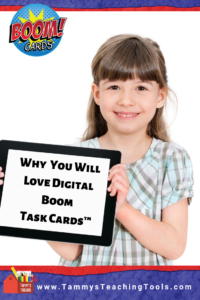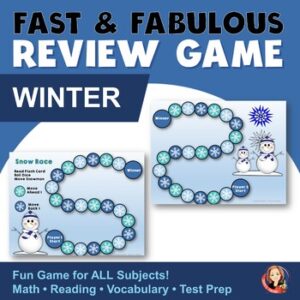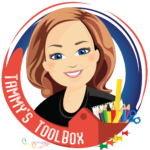Top 10 Teaching Tips for a New Year
What are the top 10 teaching tips and effective teaching strategies? Well, that question will be different depending on who you ask. Many effective teaching strategies can be essential additions to your teaching toolbox.
Each teacher must look at their classroom, students’ abilities, and goals to determine what works best for them. Something that works well in one situation may not work for another.
As we get ready to start a new year, I wanted to share my top ten tips for making your classroom (or homeschool, tutoring session, etc…) the best it can be.
Add these tips to your teaching toolbox, and make sure to see more resources and a ♥ freebie at the end.
Tammy’s Top 10 Tips for Teaching
1 Build Relationships
This is my #1 tip!
► Build positive relationships with your students right away. Even your most challenging students will work for you and with you when they like you and feel respected.
► Take the time to get to know their individual likes and dislikes. Understand their personal situations. Students should feel that you like them and care about the things that are important to them.
► There is always something about each student that you can find to like. Let them know it every day. Go out of your way to make your students feel special and needed.
► Forgiveness and understanding work far better than ruling your classroom by fear.
2 Use Explicit Directions
► Make sure your directions are clear, very detailed, and at the level of your students’ understanding.
► Repeat directions and give visual examples.
► Model Everything
► After telling students what to do, it’s essential to show them exactly how to do it.
► Model everything! Then have the kids model it.
► Show both the right way and the wrong way.
3 Give Feedback
► Students don’t always know if they’re doing a good job without you telling them so.
► Use explicit positive feedback.
► Regularly provide written and verbal feedback for individual and group assignments.
► Remember that students often don’t know why something is wrong, so explain why you’ve marked something incorrect.
► Let the students provide you feedback to tell you how you’re doing.
4 Mistakes are OK!
► If something goes wrong in a lesson, take that opportunity to turn the mistake into a teaching moment. Some of the best learning happens when a lesson plan takes a turn.
► Make intentional mistakes and ask the class to fix them. This requires kids to apply the knowledge they’ve gained.
► Be flexible. Sometimes you need to stop what you are doing and try something new. It’s OK!
5 Use Teamwork
► Group work is a fun and interactive way to teach a lesson. Cooperative assignments encourage teamwork and help your class to learn from each other.
► Pair children who need extra support with those who better understand the material. This way, those who are stronger in the subject can share their knowledge to help their peers understand it better.
6 Switch Roles
This is one of my favorite teaching tips. Let the students be the teacher!
► Let your students display their knowledge and share it with you and their classmates. This is a great confidence builder and fun too.
7 Be Prepared
This is one of the most important tips! I have experienced some embarrassing and terrible teaching moments because I thought I could wing it.
► Prepare, prepare, prepare
► Over prepare
► Have examples and pre-made samples ready.
► Have all the materials needed for the lesson and pre-prep if needed.
► Be ready for the unexpected. There will be fast finishers, interruptions, and students who need more detailed help.
► Know your subject well.
► Have different ways of explaining the same information.
► Think about what questions your students may have, what reaction they may have to a topic, what they could relate the information to, and vocabulary they may not know.
► Plan at the right level. Material and directions should be easy to understand but not too simple to be boring or unchallenging.
 Be sure to check out Tammy’s Toolbox on TPT to find resources and freebies that will make your planning easier. If you are not on my mailing list, sign up here and get exclusive access to a free growing library of resources for teaching struggling readers.
Be sure to check out Tammy’s Toolbox on TPT to find resources and freebies that will make your planning easier. If you are not on my mailing list, sign up here and get exclusive access to a free growing library of resources for teaching struggling readers.
8 Use Multisensory Activities
► Engage as many modalities as possible. Use music, movement, and touch to provide multisensory activities.
► Add games, plays, crayons, dough, art supplies, etc. Fill their heads with the knowledge in fun, exciting ways.
9 Have Fun
► Let loose, laugh, relax and have fun. Everyone learns better when enjoying themselves.
10 Use Technology
► Technology is an integral part of life today. Use it to make learning exciting and interesting.
► Find technology that makes your teaching and planning easier.
→ Check out Boom Cards for some great digital activities.
► Make sure you have assisted technology options for students who need it.
→ Here are a couple of books you may find helpful. (This post contains affiliate links)
Teaching Tips for Challenging Behaviors
Teaching Tips for Kids with Dyslexia and Other Reading Disabilities
Check out my other posts with tips to help you have a great year.
Multisensory Teaching and Learning Tips
Ways to Use Humor in the Classroom
Tips for Teaching Social-Emotional Learning
♥ Have Fun Teaching with this Freebie ♥
HAPPY NEW YEAR,





